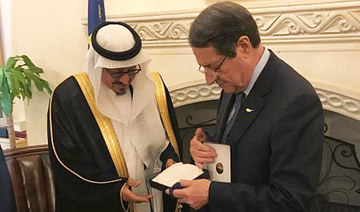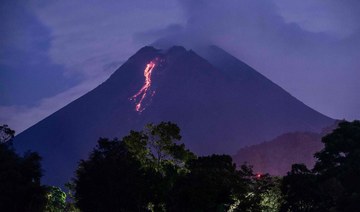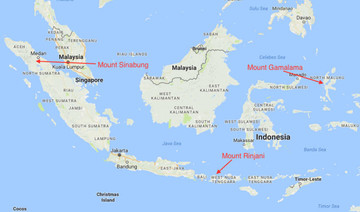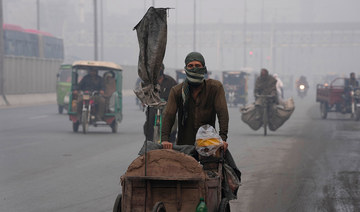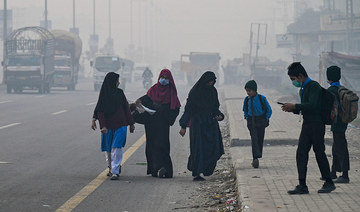NICOSIA: Dairy farmers on Cyprus refer to halloumi as “white gold.” The salty, rubbery cheese made from goats’ and sheep’s milk and prized for its ability to withstand a grill without melting is the country’s leading export.
Cypriot authorities have spent years trying to get the European Union to recognize halloumi, or hellim in Turkish, as a traditional product of the east Mediterranean island nation. Receiving the EU’s top quality mark — the “Protected Designation of Origin” — would mean only halloumi made in Cyprus could be marketed abroad under that name.
The nation’s farmers and producers want the Cyprus-specific designation to keep makers of inferior cheeses in other countries from claiming a slice of their market of over 200 million euros ($222 million). Cypriot producers say demand from overseas is projected to hit new highs in the next few years, thanks to heat-tolerant halloumi’s growing popularity as a meat alternative.
However, ethnically divided Cyprus’ complex politics so far have stymied the bid to protect the halloumi name. The difficulty lies in a dispute over how to lawfully get cheese made in the country’s breakaway northern third to foreign markets. The self-declared Turkish Cypriot state is recognized only by Turkey and goods produced there cannot be exported directly.
Cyprus was split along ethnic lines in 1974 when Turkey invaded in the wake of a coup by supporters of union with Greece. The country joined the EU in 2004, but EU rules and regulations only apply to the southern, Greek Cypriot part of the island led by an internationally recognized government.
A European Parliament member from Cyprus has accused the EU’s executive commission of letting the PDO application for halloumi grow moldy. The government hopes the new European Commission seated last month will find a way around the quandary.
Halloumi/hellim was put on track for an exclusive geographic designation amid much fanfare in 2015, when relaunched negotiations between the rival Greek Cypriot and Turkish Cypriot leaders brimmed with hope of delivering a deal to reunify the island as a two-zone federation.
A compromise was struck for the Bureau V eritas — a European body that certifies food and agricultural products — t o perform checks on halloumi/hellim produced on both sides of the ethnic divide to ensure it met EU health and safety standards.
But the peace talks eventually collapsed, and the application has languished since then.
The Cypriot government says the agreement foresaw the export to European markets of vetted, Turkish Cypriot-produced cheese through EU-recognized ports in the south. Britain, Sweden and Germany currently are the top three markets for Cyprus’ halloumi.
But Turkish Cypriot authorities say there was no such understanding. They accuse Greek Cypriots of blocking the European Commission’s effort to enable halloumi/hellim exports from the island’s north.
“Turkish Cypriot producers should be able to export PDO-registered hellim/halloumi as they deem viable,” Turkish Cypriot Chamber of Commerce President Turgay Deniz said. “They should not be restricted to trading across (the dividing line) and via the ports in the south.”
According to Deniz, 13 Turkish Cypriot halloumi/hellim producers export around 30 million euros ($33 million) worth of the cheese to Turkey and Gulf countries. The cheese reaches Gulf nations through Turkey.
Cyprus’ Agriculture Ministry says it intends to keep pushing to clinch the exclusive mark and “to solve soon the remaining issues relating to the registration of halloumi/hellim for the benefit of all Cypriot producers.”
The European Commission says it’s in contact with the Cypriot government and Turkish Cypriots to “ensure an outcome.”
But Cypriot European Parliament member, Costas Mavrides, alleges the Commission is “arbitrarily” stalling it’s approval for halloumi to get the PDO. He said there’s no legal reason for the cheese not to gain the designation and that the only step that’s left is the green light from the Commission.
Mavrides is urging the Cypriot government to take the matter to the EU Court of Justice so halloumi/hellim gets the coveted moniker.
Farmers’ organizations fully back the government’s PDO drive for halloumi. But curiously, a segment of the cheese-making community is voicing its dissent at the cheese clinching the designation amid concerns that this could lead to job losses and shrinking revenue.
For halloumi/hellim t o secure the designation, it must conform to a Cyprus government directive that it must contain at least 51% sheep’s and goats’ milk. That’s in line with a traditional Cypriot recipe dating back some 500 years when cows were a rare commodity. Now, the cheese is made with mostly cow’s’ milk.
But Cheesemakers’ Association President George Petrou warns that more than one-third of the 13,000 Cypriot families in the halloumi/hellim business would find themselves out of a job if they couldn’t use as much cows’ milk in their cheese.
Cheese exports would drop by at least half, as production would plummet because of a current shortage of sheep and goat milk, Petrou estimated.
Petrou says cheese-makers instead want authorities to pursue a geographical origin designation whose rules are more flexible on how much cow milk can be used.
“As cheese-makers, we want a solution that won’t reduce exports or lead to job losses,” Petrou told The Associated Press.
Other industry groups see holes in that argument. Rejecting the idea of using less cows’ milk loses sight of the long-term benefits that a PDO mark would offer Cypriot halloumi makers, says Michalis Lytras, president of the Pancyprian Farmers’ Union.
The geographic designation would protect local producers from foreign competitors who might use cheaper, possibly government-subsidized cow milk to make halloumi/hellim.
A PDO designation wouldn’t preclude finding solutions addressing cheesemakers’ concerns, like possibly marketing halloumi/hellim made with mostly cow milk under a different name.
“We can’t sacrifice those long-term benefits for short-term gains,” said Lytras.
Takis Christodoulou, president of the New Farmers’ Movement, says the high sheep and goat milk content appeals to health-conscious European consumers who are helping to fuel halloumi sales.
Christodoulou disputes that revenue from halloumi/hellim exports would drop as steeply as Petrou contends. He said while there may be a dip in cheese exports, PDO-designated halloumi/hellim would command higher prices in foreign markets.
“This is the natural product of Cyprus, and we couldn’t be prouder of it,” said Christodoulou.
White gold: Cyprus’ halloumi cheese entangled in politics
https://arab.news/yt7y4
White gold: Cyprus’ halloumi cheese entangled in politics
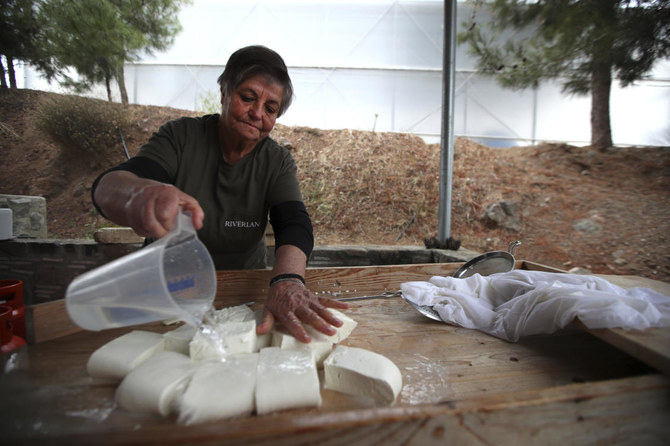
- Cypriot authorities have spent years trying to get the EU to recognize halloumi as a traditional product of the east Mediterranean island nation
AI’s relentless rise gives journalists tough choices

- AI tools imitating human intelligence are used to transcribe sound files, summarize texts and translate
- Columbia University teacher says collaborating with AI “tempting” in the face of increasingly right media resources
PERUGIA, Italy: The rise of artificial intelligence has forced an increasing number of journalists to grapple with the ethical and editorial challenges posed by the rapidly expanding technology.
AI’s role in assisting newsrooms or transforming them completely was among the questions raised at the International Journalism Festival in the Italian city of Perugia that closes on Sunday.
AI tools imitating human intelligence are widely used in newsrooms around the world to transcribe sound files, summarize texts and translate.
In early 2023, Germany’s Axel Springer group announced it was cutting jobs at the Bild and Die Welt newspapers, saying AI could now “replace” some of its journalists.
Generative AI — capable of producing text and images following a simple request in everyday language — has been opening new frontiers as well as raising concerns for a year and a half.
One issue is that voices and faces can now be cloned to produce a podcast or present news on television. Last year, Filipino website Rappler created a brand aimed at young audiences by converting its long articles into comics, graphics and even videos.
Media professionals agree that their trade must now focus on tasks offering the greatest “added value.”
“You’re the one who is doing the real stuff” and “the tools that we produce will be an assistant to you,” Google News general manager Shailesh Prakash told the festival in Perugia.
The costs of generative AI have plummeted since ChatGPT burst onto the scene in late 2022, with the tool designed by US start-up OpenAI now accessible to smaller newsrooms.
Colombian investigative outlet Cuestion Publica has harnessed engineers to develop a tool that can delve into its archives and find relevant background information in the event of breaking news.
But many media organizations are not making their language models, which are at the core of AI interfaces, said University of Amsterdam professor Natali Helberger. They are needed for “safe and trustworthy technology,” he stressed.
According to one estimate last year by Everypixel Journal, AI has created as many images in one year as photography in 150 years.
That has raised serious questions about how news can be fished out of the tidal wave of content, including deepfakes.
Media and tech organizations are teaming up to tackle the threat, notably through the Coalition for Content Provenance and Authenticity, which seeks to set common standards.
“The core of our job is news gathering, on-the-ground reporting,” said Sophie Huet, recently appointed to become global news director for editorial innovation and artificial intelligence at Agence France-Presse.
“We’ll rely for a while on human reporters,” she added, although that might be with the help of artificial intelligence.
Media rights watchdog Reporters Without Borders, which has expanded its media rights brief to defending trustworthy news, launched the Paris Charter on AI and journalism late last year.
“One of the things I really liked about the Paris Charter was the emphasis on transparency,” said Anya Schiffrin, a lecturer on global media, innovation and human rights at Columbia University in the United States.
“To what extent will publishers have to disclose when they are using generative IA?“
Olle Zachrison, head of AI and news strategy at public broadcaster Swedish Radio, said there was “a serious debate going on: should you mark out AI content or should people trust your brand?“
Regulation remains in its infancy in the face of a constantly evolving technology.
In March, the European Parliament adopted a framework law aiming to regulate AI models without holding back innovation, while guidelines and charters are increasingly common in newsrooms.
AI editorial guidelines are updated every three months at India’s Quintillion Media, said its boss Ritu Kapur.
None of the organization’s articles can be written by AI and the images it generates cannot represent real life.
AI models feed off data, but their thirst for the vital commodity has raised hackles among providers.
In December, the New York Times sued OpenAI and its main investor Microsoft for violation of copyright.
In contrast, other media organizations have struck deals with OpenAI: Axel Springer, US news agency AP, French daily Le Monde and Spanish group Prisa Media whose titles include El Pais and AS newspapers.
With resources tight in the media industry, collaborating with the new technology is tempting, explained Emily Bell, a professor at Columbia University’s journalism school.
She senses a growing external pressure to “Get on board, don’t miss the train.”
Fighting flares at Myanmar-Thai border as rebels target stranded junta troops

- Resistance fighters and ethnic minority rebels seized the key trading town of Myawaddy on the Myanmar side of the frontier on April 11
Fighting raged at Myanmar’s eastern frontier with Thailand on Saturday, witnesses, media and Thailand’s government said, forcing about 200 civilians to flee as rebels pressed to flush out junta troops holed up for days at a bridge border crossing.
Resistance fighters and ethnic minority rebels seized the key trading town of Myawaddy on the Myanmar side of the frontier on April 11, dealing a big blow to a well-equipped military that is struggling to govern and is now facing a critical test of its battlefield credibility.
Three witnesses on the Thai and Myanmar sides of the border said they heard explosions and heavy machine gun fire near a strategic bridge from late on Friday that continued into early Saturday.
Several Thai media outlets said about 200 people had crossed the border to seek temporary refuge in Thailand.
Thai broadcaster NBT in a post on social media platform X said resistance forces used 40-milimeter machine guns and dropped 20 bombs from drones to target an estimated 200 junta soldiers who had retreated from a coordinated rebel assault on Myawaddy and army posts since April 5.
Reuters could not immediately verify the reports and a Myanmar junta spokesperson could not immediately be reached for comment.
Thai Prime Minister Srettha Thavisin said he was closely monitoring the unrest and his country was ready to provide humanitarian assistance if necessary.
“I do not desire to see any such clashes have any impact on the territorial integrity of Thailand and we are ready to protect our borders and the safety of our people,” he said on X. He made no mention of refugees.
BIG SETBACK
Myanmar’s military is facing its biggest challenge since first taking control of the former British colony in 1962, caught up in multiple, low-intensity conflicts and grappling to stabilize an economy that has crumbled since a 2021 coup against Nobel laureate Aung San Suu Kyi’s government.
The country is locked in a civil war between the military on one side and, on the other, a loose alliance of established ethnic minority armies and a resistance movement born out of the junta’s bloody crackdown on anti-coup protests.
The capture of Myawaddy and surrounding army outposts is a significant setback for a junta that has been squeezed by Western sanctions, with the town a key tax revenue source and conduit for more than $1 billion of annual border trade.
The Khaosod newspaper in a post on X showed a video of Myanmar civilians, many of them women and children, being marshalled by Thai soldiers at an entry point to Thailand.
Thailand had on Friday said no refugees had entered the country and it was discussing with aid agencies about increasing humanitarian relief to civilians on the Myanmar side.
Taiwan’s defense ministry detects 21 Chinese military aircraft

- The median line bisects the Taiwan Strait, a narrow 180-kilometer waterway separating the island from mainland China
TAIPEI: Taipei’s defense ministry said it had detected 21 Chinese military aircraft around the self-ruled island since 8:15 am (0015 GMT) on Saturday, a month before Taiwan’s May 20 inauguration of incoming president Lai Ching-te.
“17 aircraft (of the 21) crossed the median line and its extension, entered our northern, central, and southwestern (air defense identification zone), and joined PLA vessels for joint combat patrol,” it said in a statement posted on X around 11:30 am.
Taiwan’s armed forces “are monitoring the activities with our joint surveillance systems, and have dispatched appropriate assets to respond accordingly.”
The median line bisects the Taiwan Strait, a narrow 180-kilometer waterway separating the island from mainland China.
Beijing does not recognize the line as it claims democratic Taiwan as part of its territory. It has also never renounced the use of force to bring the island under its control.
China sends warplanes and naval vessels around Taiwan on a near daily basis — a move experts say is a form of “grey-zone harassment,” stopping short of an outright act of war but enough to exhaust Taipei’s armed forces.
According to the defense ministry, the 21 aerial objects detected Saturday included J-16 fighter jets and Y-8 medium-range transport aircraft, as well as drones.
The highest number around Taiwan so far this year was in March, when the ministry said 36 Chinese aircraft were detected in a single 24-hour period.
Last year’s record was in September when Beijing’s military sent 103 aircraft — 40 of which crossed the median line — in a 24-hour period.
Saturday’s show of force comes a day after China activated two aviation routes that run close to Taiwan’s outlying islands of Kinmen and Matsu.
Taipei’s Civil Aviation Administration expressed “solemn protest against China’s unilateral measures without consultation” on Friday.
The new routes make the airspace separation between the two sides “very narrow,” it said, increasing flight safety risks during bad weather or abnormal flight operations.
China’s aviation authority also said Friday the airspace around Fuzhou Changle Airport — 30 kilometers from the closest outlying Taiwanese island — would be “further optimized and adjusted” on May 16, four days before the inauguration.
Under the administration of Taiwanese President Tsai Ing-wen, tensions between Beijing and Taipei have ramped up, as she and her government do not acknowledge China’s claim.
Her deputy, Vice President Lai, won elections in January despite warnings from Beijing that he would be the cause of “war and decline” for Taiwan.
China regards Lai — who used to be outspoken about Taiwan independence — as a “dangerous separatist,” though he has moderated his views in recent years.
Hundreds of people evacuated as volcano spews clouds of ash in Indonesia
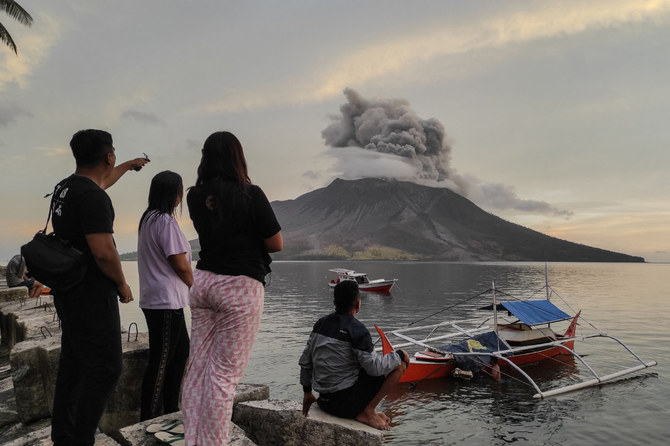
- Local authorities combed the villages surrounding the volcano and evacuated residents to safer areas by boat
- Officials worry that part of the volcano could collapse into the sea and cause a tsunami, as happened in an eruption there in 1871
MANADO, Indonesia: More than 2,100 people living near an erupting volcano on Indonesia’s Sulawesi Island were evacuated Friday due to the dangers of spreading ash, falling rocks, hot volcanic clouds and the possibility of a tsunami.
Indonesia’s Center for Volcanology and Geological Hazard Mitigation recorded at least three eruptions since Friday afternoon, with the maximum height of the eruption column reaching 1,200 meters (3,900 feet).
An international airport in Manado city, less than 100 kilometers (60 miles) from the erupting Mount Ruang, is still temporarily closed as volcanic ash was spewed into the air.
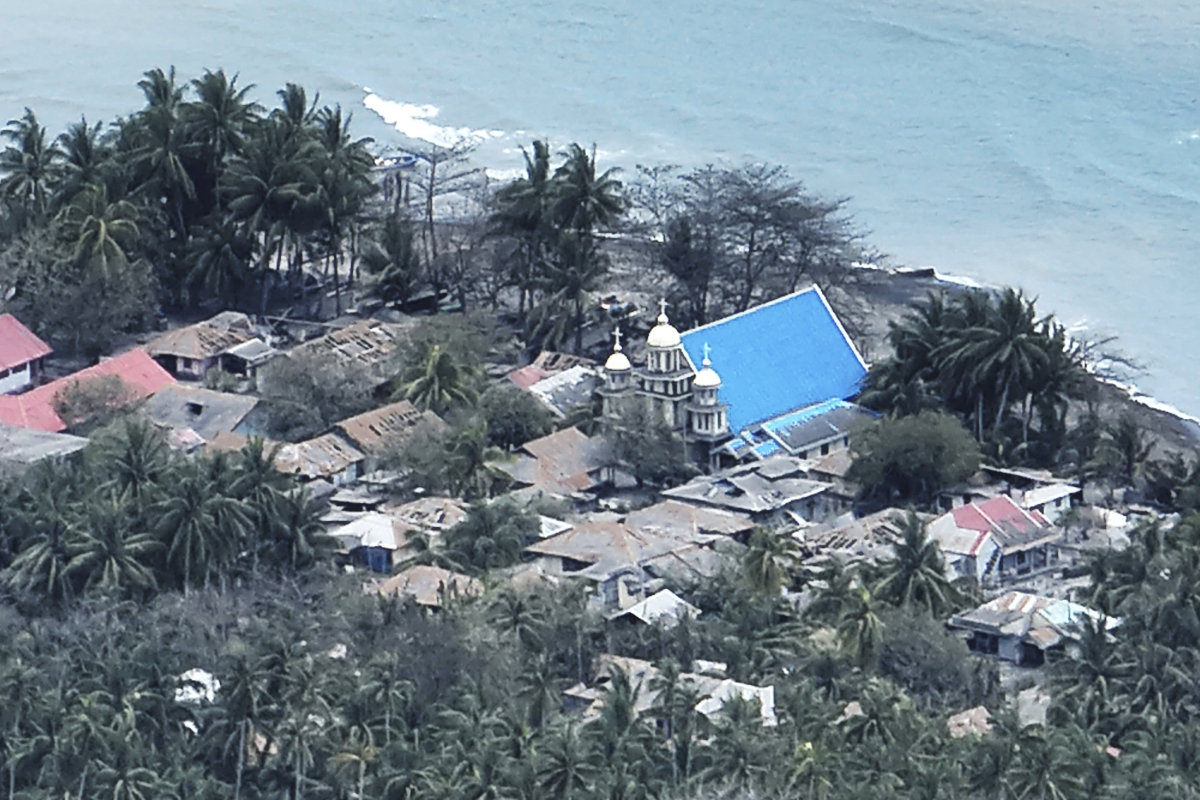
Satellite imagery from the Meteorology, Climatology and Geophysics Agency shows the ash has spread to the west, northwest, northeast and southeast, covering Manado and North Minahasa, according to a statement from Indonesia’s Transportation Ministry.
“We are still monitoring developments in the eruption of Mount Ruang and coordinating with relevant stakeholders … to anticipate the necessary actions to ensure flight safety, security and comfort,” said Ambar Suryoko, head of the regional airport authority.
More than 11,000 people were told to leave their homes that were located in the affected area. A joint team from the local authorities combed the villages surrounding the volcano and evacuated residents to safer areas by boat.
Officials worry that part of the volcano could collapse into the sea and cause a tsunami, as happened in an eruption there in 1871.
Houses, roads and other buildings were covered by gray volcanic ash, and many roofs were broken by debris spewed from the eruption.

Mount Ruang saw at least five large eruptions Wednesday, causing the Center for Volcanology and Geological Hazard Mitigation to issue its highest level of alert. People were ordered to stay at least 6 kilometers (3.7 miles) from the 725-meter (2,378-foot) mountain.
The observation from the agency on Friday said white smoke was rising from the main crater with medium to thick intensity.
East of the volcano, Tagulandang Island could be at risk if a collapse occurred. Its residents were among those being told to evacuate. Indonesia’s National Disaster Mitigation Agency said residents would be relocated to Manado, a journey of 6 hours by boat.
Indonesia, an archipelago of 270 million people, has 120 active volcanoes. It is prone to volcanic activity because it sits along the “Ring of Fire,” a horseshoe-shaped series of seismic fault lines around the Pacific Ocean.
Finance firms urge ambitious action on plastic pollution

- Curtailing the estimated 400 million metric tonnes of waste produced every year is a crucial part of efforts to protect biodiversity, with microplastics found everywhere from the mountainous Himalayas to staple foods and even human blood
LONDON: A group of 160 financial companies on Friday urged governments to agree a treaty to end plastic pollution that would help spur private sector action, ahead of the next round of global talks in Canada.
The fourth meeting of the Intergovernmental Negotiating Committee on Plastic Pollution (INC-4) is due to be held in Ottawa next week to lay the groundwork for an eventual deal before the end of the year.
Curtailing the estimated 400 million metric tonnes of waste produced every year is a crucial part of efforts to protect biodiversity, with microplastics found everywhere from the mountainous Himalayas to staple foods and even human blood.
To help fix the problem, the finance firms, which include Britain’s biggest investor Legal & General Investment Management and Canadian pension investor CDPQ, called for a policy framework backed up by binding rules.
Among specific steps, the group called for the treaty to set an objective for all public and private finance to be consistent with the goal of eliminating plastic pollution, similar to that in the Paris climate agreement and the Kunming-Montreal global biodiversity framework.
It also called for companies to assess and disclose plastic-related risks and opportunities; clearer plastic-related policies and targets from governments in areas like waste creating and recycling; and for further private investment to be directed to ending plastic pollution.
“A clear transition pathway laid out in the Treaty will help leverage finance at scale for this massive task of ending plastic pollution worldwide,” said Anne-Sophie Castelnau, global head of sustainability at ING, one of the signatories.
Steve Hardman, CEO of Plastic Collective, an NGO which designed the world’s first plastic waste reduction bond alongside Citi and the World Bank, welcomed the support but called for business to provide more financial solutions.
In January, the World Bank issued the $100 million bond to finance plastic-reduction projects in Ghana and Indonesia. Investors will be paid a rate linked to plastic removal credits generated by the projects.






